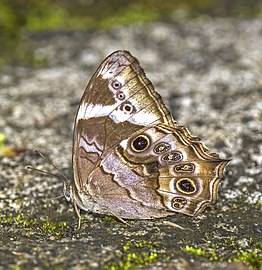Lethe drypetis
This article's tone or style may not reflect the encyclopedic tone used on Wikipedia. (June 2024) |
| Lethe drypetis | |
|---|---|

| |
| Female, Sri Lanka | |
| Scientific classification | |
| Domain: | Eukaryota |
| Kingdom: | Animalia |
| Phylum: | Arthropoda |
| Class: | Insecta |
| Order: | Lepidoptera |
| Family: | Nymphalidae |
| Genus: | Lethe |
| Species: | L. drypetis
|
| Binomial name | |
| Lethe drypetis (Hewitson, 1863)
| |
Lethe drypetis, the Tamil tree brown,[1][2] is a species of Satyrinae butterfly found in South India and Sri Lanka.[1][2]
Description
[edit]Male: Upper-side very dark Vandyke brown; forewing uniform: hindwing with a postdiscal series of three or four blind black ocellar spots. Underside, brown; forewing below vein 2 and terminal margin paler, with a broad band across the cell, the wing medially and at apex suffused with lilac, bearing an incurved postdiscal series of five, blind black ocelli. Hindwing: sub basal and discal narrow transverse lilac bands, the former sinuous, the latter angulated on vein 4, and an arched postdiscal series of black fulvous-ringed ocelli, some with disintegrate centres; the wing medially suffused with lilac, the ocelli with lilacine lunules on both sides. Forewings and hindwings with slender lilacine subterminal and broader ochraceous terminal lines.[3]
Female: Similar to male, with ground colour paler; a broad oblique white discal bar and two white preapical spots on the upper-side of the forewing; a large, rectangular black subterminal mark in interspaces and a white spot above and below it, on the upper-side of the hindwing. Underside similar to the underside in the male, all the markings more prominent, the lilac, ochraceous and brown shades paler; the broad discal bar on forewing, as on the upper-side, joined by a nearly vertical lilacine white band bearing the series of ocelli.[3][4]
On the hindwing, a brown transverse discal band is very broadly produced between veins 4 and 5. Antennae, head, thorax and abdomen brown; antennae ochraceous at apex.[3]
Wingspan 64–68mm.[3]
Found in southern India and Sri Lanka.[3]
-
Female (left) and male (right) upper and underside pattern
-
Male, Kerala, India
-
Female, Sri Lanka
Life history
[edit]Larva. "Fusiform; head conical, the vertex pointed and projected forward, anal segment pointed and projected hind ward. Colour pale green, with paler transverse lines on each segment; a lateral and a sublateral pale-bordered reddish stripe extending the whole length, including the anal segment. Feeds on bamboo." (After Frederic Moore)[3]
Pupa. "Suspended by the tail, broad and truncated anteriorly, abdominal segments dorsally convex, head and vertex both pointed; colour pale green." (After Moore)[3]
References
[edit]- ^ a b Varshney, R.K.; Smetacek, Peter (2015). A Synoptic Catalogue of the Butterflies of India. New Delhi: Butterfly Research Centre, Bhimtal & Indinov Publishing, New Delhi. p. 165. doi:10.13140/RG.2.1.3966.2164. ISBN 978-81-929826-4-9.
- ^ a b Savela, Markku. "Lethe drypetis (Hewitson, 1863)". Lepidoptera and Some Other Life Forms. Retrieved July 2, 2018.
- ^ a b c d e f g
 One or more of the preceding sentences incorporates text from this source, which is in the public domain: Bingham, Charles Thomas (1905). Fauna of British India. Butterflies Vol. 1. pp. 79–80.
One or more of the preceding sentences incorporates text from this source, which is in the public domain: Bingham, Charles Thomas (1905). Fauna of British India. Butterflies Vol. 1. pp. 79–80.
- ^
 One or more of the preceding sentences incorporates text from this source, which is in the public domain: Moore, Frederic (1890–1892). Lepidoptera Indica. Vol. I. London: Lovell Reeve and Co. pp. 257–259.
One or more of the preceding sentences incorporates text from this source, which is in the public domain: Moore, Frederic (1890–1892). Lepidoptera Indica. Vol. I. London: Lovell Reeve and Co. pp. 257–259.



